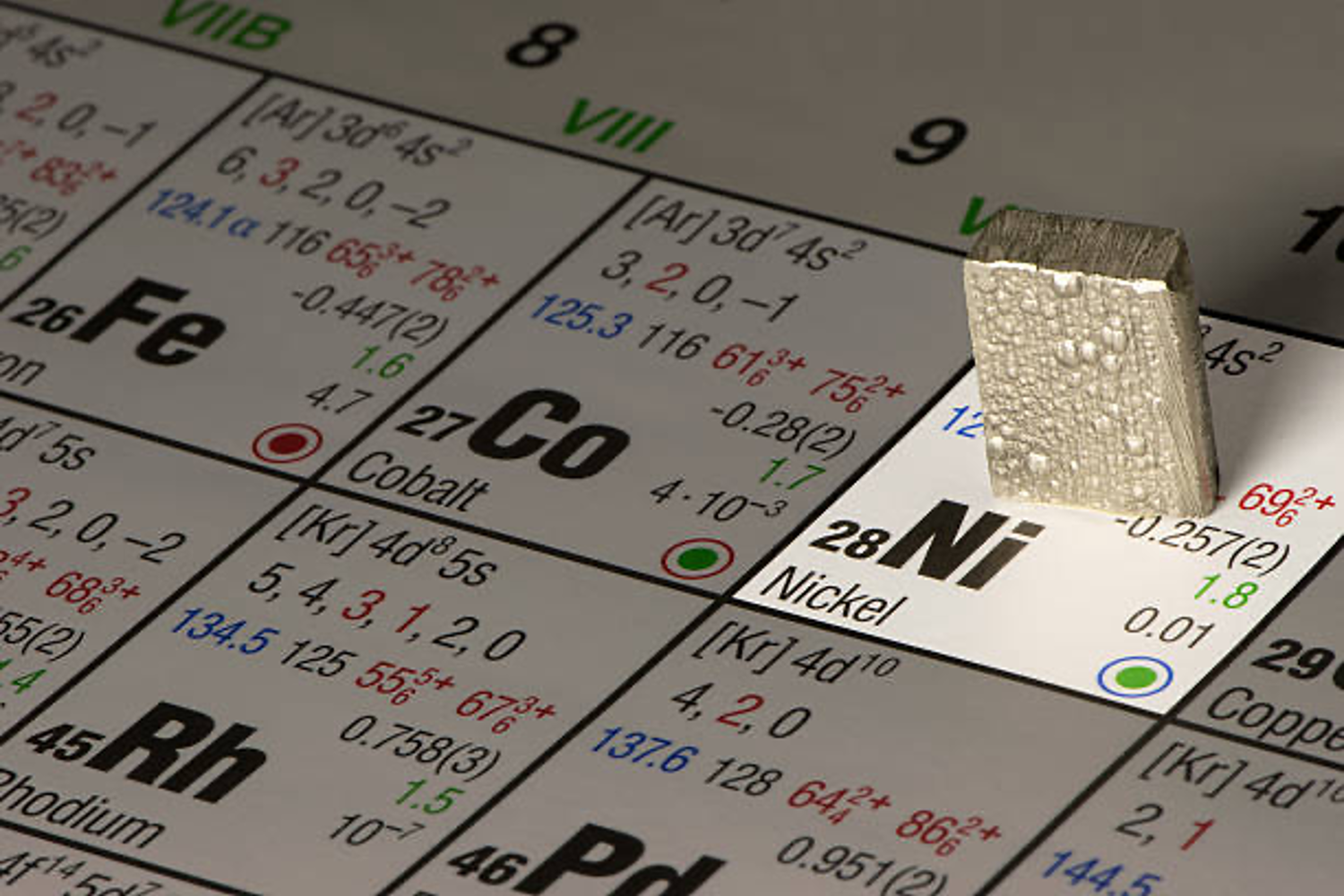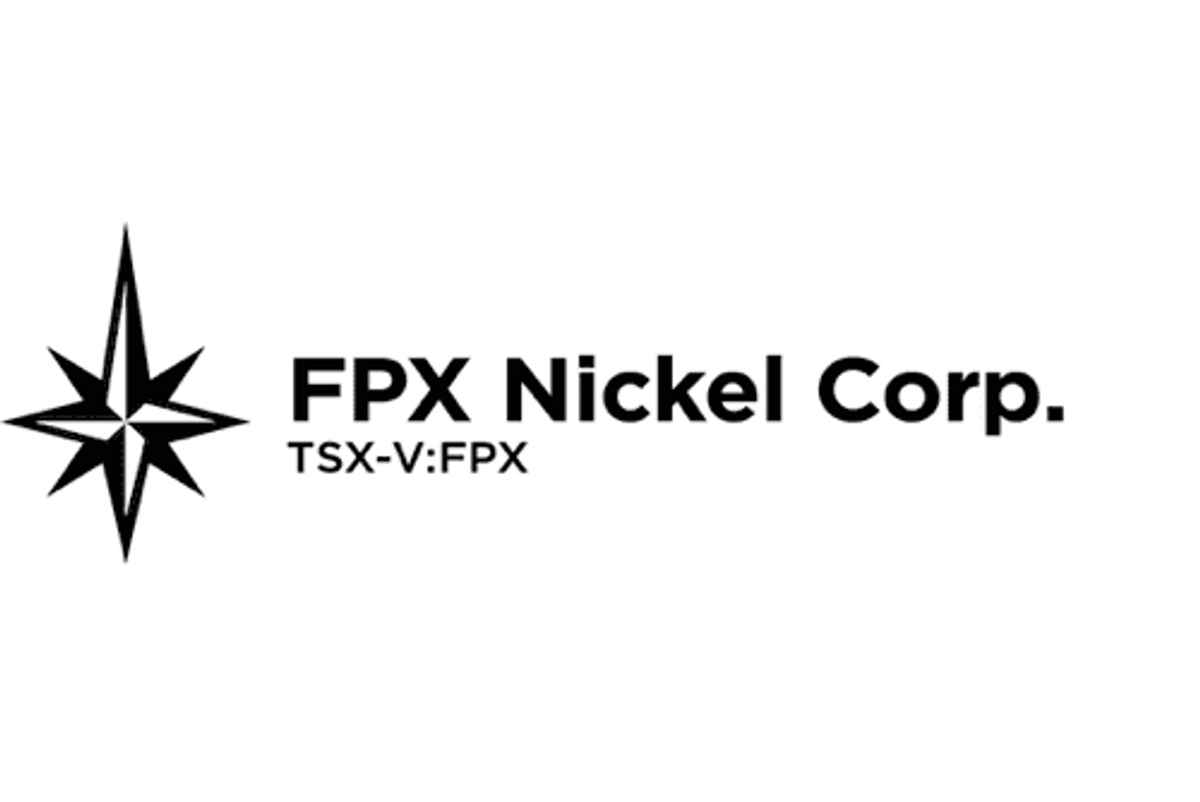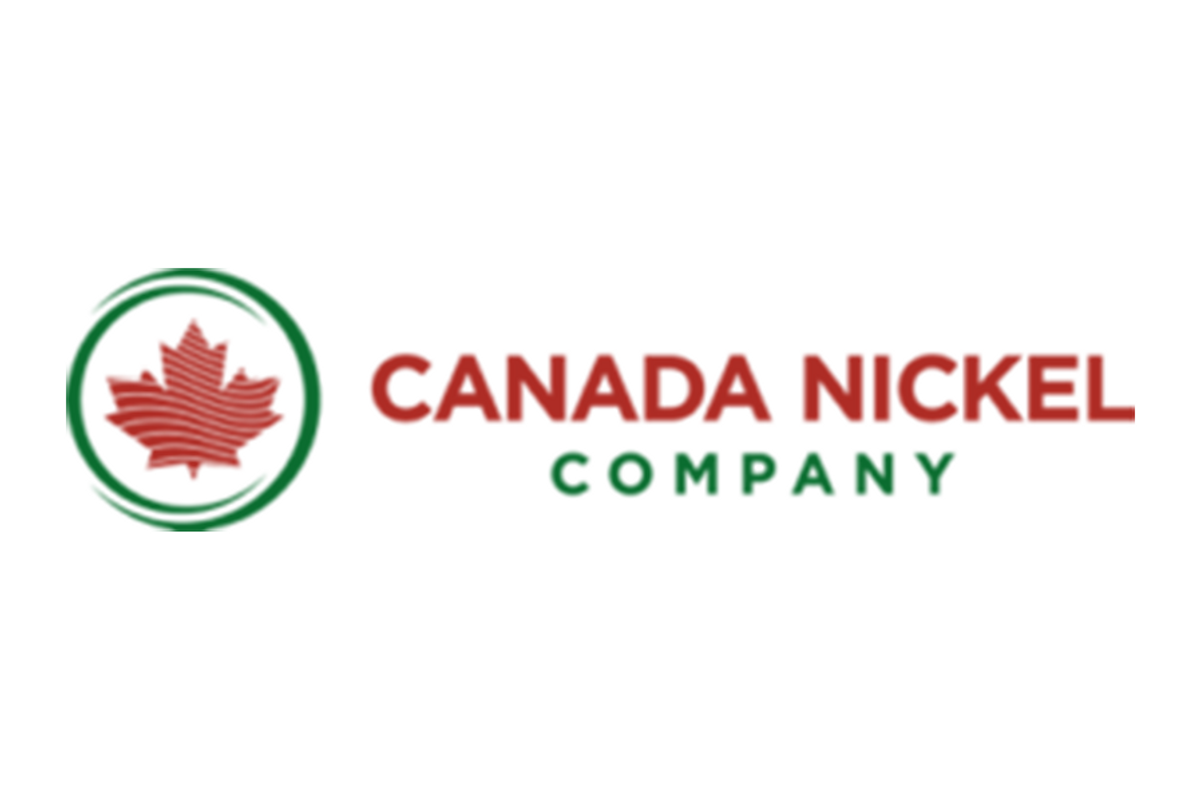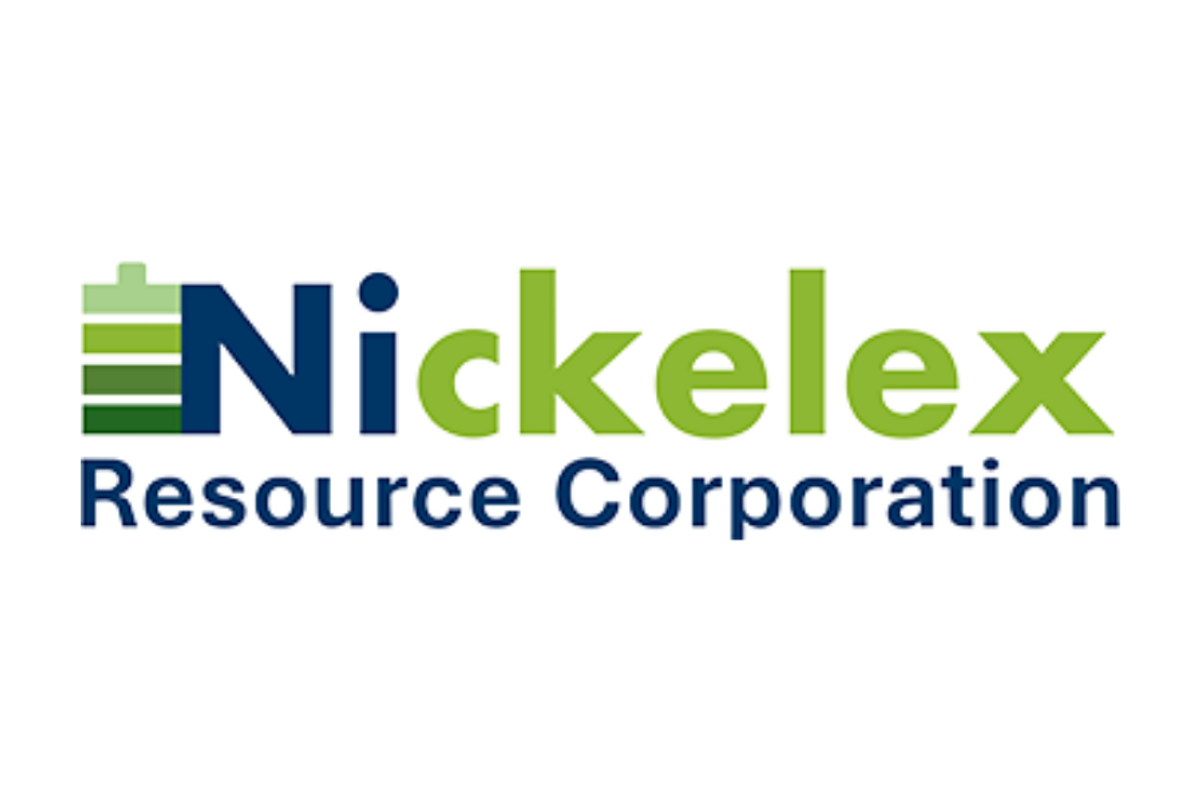
October 17, 2023
Nickelex Resource Corporation (TSXV: NICK) ("Nickelex" or the "Company") reports that it has signed a definitive agreement with CanAlaska Uranium Ltd. ("CanAlaska") on October 13, 2023, to earn up to an 80% interest in four projects, consisting of the Strong, Strong Extension, Moak North and Wilson Mineral Exploration Licenses in the Thompson Nickel Belt ("TNB"), Manitoba (the "Projects"). (See Figure 1)
The definitive agreement provides that Nickelex may earn:
- a 49% interest in the Projects by making a cash payment of $35,000, issuing 5,000,000 common shares in the capital of the Company ("Shares") and incurring exploration expenditures of $2,000,000 over the first 2 years;
- an increased interest to 70% by making an additional cash payment of $50,000, issuing 7,500,000 additional Shares and incurring additional exploration expenditures of $3,500,000 by the end of the third year; and
- an increased interest to 80% by making an additional cash payment of $65,000, issuing 25,000,000 additional Shares and incurring additional exploration expenditures of $3,500,000 by the end of the fifth year. In the event any Share issuance would cause CanAlaska to become a new "Control Person" (as such term is defined in TSXV policies), then Nickelex will be required to obtain shareholder approval to same before issuing such Shares in accordance with TSXV policies. If shareholder approval is not received, Nickelex may then pay the outstanding obligation in cash in lieu of Shares based on the fair market value of the Shares at the time of payment.
The Company will also pay CanAlaska $3,000,000 after completing a positive feasibility study on the Projects (such payment may be satisfied in Shares at Nickelex's sole discretion, subject to shareholder approval in the event such issuance would cause CanAlaska to become a new Control Person).
This arm's length transaction is considered a Fundamental Acquisition under the policies of the TSX Venture Exchange. The definitive agreement is subject to TSX Venture Exchange approval.
During the 49% and 70% earn-in stages, CanAlaska will be the operator of the Projects and will be entitled to charge an operator fee. Nickelex will have deciding voting rights on annual exploration programs while sole funding at the various option stages and will have the right to assume operatorship after successfully earning a 70% interest in the Projects.
After the successful completion of the last of the 49%, 70% and 80% earn-in stages, the parties will enter into a joint venture agreement, under which the parties will either co-contribute on a simple pro-rata basis or dilute on a pre-defined straight-line dilution formula. Any party diluting to a 10% interest will automatically forfeit its interest in the Projects and in lieu thereof will be granted a 2% net smelter return royalty on the Projects, half of which may be purchased by the other party at its sole discretion for $2,000,000 at any time prior to the commencement of commercial production.
An area of mutual interest will extend two km from the outer boundary of the four properties comprising the Projects, excluding all properties within such area that are currently held by CanAlaska.
To view an enhanced version of this graphic, please visit:
https://images.newsfilecorp.com/files/5345/184223_f2105577f45a69ff_002full.jpg
The Projects, located 35 km north of Thompson, Manitoba, consist of four Mineral Exploration Licenses ("MEL"), the Strong, Strong Extension, Moak North and Wilson MELs, and cover an area of 30,283 hectares. The Projects are at the north end of the TNB and cover rock lithologies similar to host rocks of other major nickel deposits in the TNB. The Company is planning a $2 million exploration program over two non-contingent stages of exploration, an initial phase of $500,000 to refine drill targets by detailed ground geophysics, with a second phase 3,500 metres of 10 - 12 diamond drill holes at an estimated cost of $1,500,000.
Exploration on the Projects was initiated in the late 1950s, and to date, 139 diamond drill holes have been completed on the properties, with 126 holes drilled prior to 1980, and an additional 13 holes drilled in the early 2000s. Historical drillholes predominantly targeted EM anomalies associated with magnetic anomalies, and several holes successfully intersected the favourable Opswagan Group and several intersected rocks of the Pipe Formation. Sulphides are abundant in many holes, however, nickel bearing intersections were limited to 1 - 3 metre widths of 0.1 - 0.2% nickel. The geophysics completed in 1998 (EM and magnetics) and 2007 (VTEM) on the Strong MEL and subsequent interpretation has resulted in the identification of 14 high priority targets that have had only limited drill testing. Preliminary ground geophysics is required on these targets to detail and prioritize the drill sites. It is estimated that ground geophysics will establish 10 - 12 targets for drilling.
In summary, Nickelex is well-structured with an experienced geologic team, management group, and Board of Directors, and with an exciting portfolio of projects in the critical metal EV sector.
To view an enhanced version of this graphic, please visit:
https://images.newsfilecorp.com/files/5345/184223_f2105577f45a69ff_003full.jpg
The Company also reports that it has granted incentive stock options to directors, officers and consultants to purchase an aggregate 3,650,000 common shares. The options are exercisable at a price of $0.05 per share for a period of five years and are subject to the policies of the TSX Venture Exchange.
Nickelex is focused on large Class 1 Nickel Deposit Discoveries in Canada and delivering the critical metals needed to power future EV demands and continued stainless steel growth.
John R. Kerr. P. Eng., is the President and director of Nickelex Resource Corporation and a Qualified Person as defined by National Instrument 43-101. He has read and approves the technical content of this release.
On behalf of the Board of Directors,
"John Kerr"
John Kerr, President, Nickelex Resource Corporation
For further information, please visit Nickelex's website at www.nickelexresource.com or contact us at 604.641.2759 or by email at corpdev@mnxltd.com.
Neither TSX Venture Exchange nor its Regulation Services Provider (as that term is defined in the policies of the TSX Venture Exchange) accepts responsibility for the adequacy or accuracy of this release.
This news release may contain forward-looking statements including but not limited to comments regarding the completion of the property transaction, the timing and content of upcoming work programs, geological interpretations, receipt of property titles, potential mineral recovery processes, etc. Forward-looking statements address future events and conditions and therefore involve inherent risks and uncertainties. Actual results may differ materially from those currently anticipated in such statements. These statements are based on a number of assumptions, including, but not limited to, assumptions regarding general economic conditions, interest rates, commodity markets, regulatory and governmental approvals for Nickelex Resource Corporation's projects, and the availability of financing for Nickelex Resource Corporation's projects on reasonable terms. Factors that could cause actual results to differ materially from those in forward looking statements include market prices, exploitation and exploration successes, the timing and receipt of government and regulatory approvals, and continued availability of capital and financing and general economic, market or business conditions. Nickelex Resource Corporation does not assume any obligation to update or revise its forward-looking statements, whether as a result of new information, future events or otherwise, except to the extent required by applicable law.
The Conversation (0)
08 July
South32 Announces Up to US$100 Million Sale of Cerro Matoso, Shifts Focus to Critical Minerals
South32 (ASX:S32,OTC Pink:SHTLF) said on Monday (July 7) that it has agreed to sell the Cerro Matoso nickel mine in Colombia to a subsidiary of CoreX Holding following recent changes in the nickel market.
South32 now plans to focus on critical minerals, describing its flagship Hermosa project in Patagonia as a “next generation mine.” Hermosa hosts the zinc-lead-silver Taylor sulphide deposit, and the zinc-manganese-silver Clark oxide deposit.
"The Transaction is consistent with our strategy and will further streamline our portfolio toward higher margin businesses in minerals and metals critical to the world’s energy transition,” said South32 CEO Graham Kerr.
“The Transaction will deliver a clean separation of Cerro Matoso and provide additional balance sheet flexibility to support investment in our growth options in copper and zinc.”
Cerro Matoso is an open-cut mine in Northern Colombia located about 20 kilometres southwest of Montelibano. The project boasts almost 40 years of operations, with 40.6 kilotonnes of payable nickel produced in 2024.
Under the agreement, CoreX will make cash payments of up to US$80 million worth of price-linked consideration based on future production and nickel prices, and up to US$20 million based on permitting milestones within the next five years for the Queresas & Porvenir North project. The US$20 million will come in four equal payments.
South32 said it intends to work with the buyer, the company’s workforce, local communities, government, customers and suppliers to support the transfer of ownership.
Upon transaction completion, all economic and operating control of Cerro Matoso will fall under the buyer’s hands. Cerro Matoso will be reported in South32's underlying financial results as a discontinued operation once the transaction is completed.
Subject to certain conditions such as international merger clearances and a reorganisation of the entity which holds Cerro Matoso, the transaction is scheduled to be completed towards the end of this year.
Don’t forget to follow us @INN_Australia for real-time news updates!
Securities Disclosure: I, Gabrielle de la Cruz, hold no direct investment interest in any company mentioned in this article.
Keep reading...Show less
19 June
Tartisan Nickel Corp. Completes Phase 2 Construction on the Kenbridge Nickel All-Season Access Road, Receives Critical Realignment Road Permit
Tartisan Nickel Corp. (CSE: TN) (OTCQB: TTSRF) (FSE: 8TA) ("Tartisan", or the "Company") is pleased to announce that work on the Kenbridge Nickel Project access corridor has achieved Phase 2 completion and has made significant improvements to the operational access road.
The Kenbridge Nickel-Copper-Cobalt Project consists of 93 contiguous patents, 153 single cell mining claims and 4 Mining Licenses of Occupation totaling 4,273 ha. The Kenbridge Property is 40 kms from paved Highway 71 via the Maybrun gravel road. The Kenbridge Property turnoff is approximately 28 kms into the Maybrun Road. The Kenbridge Project is then approximately 12.7 kms to the Kenbridge 622-meter shaft and the Kenbridge core shack. The Kenbridge Critical Minerals Project was historically only accessible by floatplane or by ATV, which made Project logistics expensive and difficult.
Phase 2 of the Kenbridge Road Project prioritized establishing reliable year-round pickup access to the Kenbridge site and core shack. This phase prioritized stabilizing key road infrastructure following winter construction.
With spring break-up complete, winter-built road sections were reshaped and compacted to address settling and ensure safe all-season access. Rehabilitation activities included subgrade shaping, grade capping, and gravel placement, with additional material added to steep approaches to improve vehicle traction and safety.
A significant focus was on drainage improvements:
- 37 cross-drain culverts were installed to support proper water flow and preserve long-term road stability and environmental integrity.
- Erosion control and environmental protection measures were implemented throughout the corridor to safeguard sensitive areas.
Additional work included:
- Survey and ribboning for Phase 3 realignments to support safe and efficient low-bed and fuel trucks to the Kenbridge core shack
- Site cleanup and removal of historical debris at the core shack
- Safety barrier installation along steep embankments
Collaboration with Indigenous community members and land-based resource specialists continued through several field visits, helping guide and validate project progress. Environmental stewardship and respectful land management remain central to all ongoing and upcoming phases.
Kenbridge Road Realignment Permit Approval
A major milestone in June 2025 was the approval of the Kenbridge Road Realignment Permit (Phase 3)—a result of close collaboration with Indigenous communities and with the Minister of Natural Resources staff in Kenora, Ontario. These realignments are essential for enabling safe and efficient access for low-bed transport and fuel delivery vehicles.
Key Next Steps Phase 3 elements include:
- Reconstruction of Atikwa River bridge approaches and departures
- One significant rock cut on Tartisan Nickel-patented land
- Two minor rock cuts
- Two major realignments of existing road and trail corridors
Notably, one realignment shifts the corridor away from a natural spring identified by a local Indigenous Knowledge Keeper as important to the regional watershed. While this adds cost to the project, it reflects Tartisan's continued commitment to environmental care and respect for the Land.
Tartisan Nickel Corp. remains focused on environmental protection and Indigenous partnership as we move into the next phase of development.
Mark Appleby, CEO of Tartisan Nickel Corp. states, "The Kenbridge all-season access road work continued this spring with a highly effective construction program. With receiving the Kenbridge Road Realignment Permit from the Ministry of Natural Resources, Tartisan is now able to prepare for Phase 3 construction which will allow the Company to ultimately float large equipment including the delivery of fuel into site". Appleby goes onto state, "We are gearing up for this all-important Phase 3 and road completion. We look forward to sharing our 2025 next steps, as significant plans are being put in place to commence summer exploration at the Kenbridge critical metals project."
About Tartisan Nickel Corp.
Tartisan Nickel Corp. is a Canadian-based mineral exploration and development company which owns the Kenbridge Nickel Project near Sioux Narrows, Northwestern Ontario, the Night Danger Turtle Pond project near Dryden, Ontario as well as the Sill Lake Silver Property near Sault Ste. Marie, Ontario. Tartisan Nickel Corp. common shares are listed on the Canadian Securities Exchange (CSE: TN) (OTCQB: TTSRF) (FSE: 8TA). Currently, there are 130,995,782 shares outstanding (137,784,671 fully diluted).
For further information, please contact Mark Appleby, President & CEO, and a Director of the Company, at 416-804-0280 (info@tartisannickel.com). Additional information about Tartisan Nickel Corp. can be found at the Company's website at www.tartisannickel.com or on SEDAR at www.sedarplus.ca.
This news release may contain forward-looking statements including but not limited to comments regarding the timing and content of upcoming work programs, geological interpretations, receipt of property titles, potential mineral recovery processes, etc. Forward-looking statements address future events and conditions and therefore involve inherent risks and uncertainties. Actual results may differ materially from those currently anticipated in such statements.
The Canadian Securities Exchange (operated by CNSX Markets Inc.) has neither approved nor disapproved of the contents of this press release.
Keep reading...Show less
17 June
FPX Nickel Completes Production Run of Battery-Grade Nickel Sulphate to Support Discussions with Prospective EV Battery Supply Chain Partners
FPX Nickel Corp. (TSXV: FPX) (OTCQB: FPOCF) ("FPX" or the "Company") is pleased to announce successful production of additional battery-grade nickel sulphate from its Baptiste Nickel Project ("Baptiste" or the "Project"). Building on the success of previous testing campaigns, a production run was completed to produce larger quantities of nickel sulphate crystals. The nickel sulphate samples, which meet the strict target specifications for battery applications, will be provided to selected prospective downstream partners including pCAM producers, battery companies, and automakers pursuing supply security, traceable sourcing, and low carbon intensity production.
"The production of high-purity nickel sulphate further positions us to engage in strategic discussions with prospective downstream partners across the global EV supply chain," commented Martin Turenne, FPX Nickel's President and Director. "This milestone further demonstrates the strategic flexibility of the Baptiste awaruite concentrate and the technical maturity of the awaruite refining process."
Overview
As described in the Company's October 15, 2024 news release, FPX completed a pilot-scale refining test program to advance the technical maturity of refining the Baptiste awaruite concentrate to nickel sulphate. This test program included continuous, pilot-scale leaching to produce low-impurity leach solution. A small portion of the leach solution was further advanced through purification and crystallization operations to nickel sulphate crystals to demonstrate the technical viability of the purification process. The remainder of leach solution was retained for future testing including continuous, pilot-scale processing of the purification and crystallization area, ensuring the final refinery strategy is supported by purification and crystallization requirements defined in collaboration with FPX Nickel's current and prospective downstream partners.
FPX recently re-engaged Sherritt Technologies Ltd. to conduct an additional nickel sulphate production run, building on Sherritt's successful completion of the previous pilot-scale refining test program. In the current testing campaign, a portion of this remaining leach solution has been processed to produce larger quantities of nickel sulphate crystals. As with previous testing campaigns, the quality of the produced nickel sulphate, presented in Table 1, meets the strict target specifications for battery applications. To further advance the produced qualification process, the nickel sulphate samples will be provided to prospective downstream partners to ensure the quality and suitability of the nickel sulphate for their battery manufacturing process. Figure 1 shows a portion of the nickel sulphate samples produced.
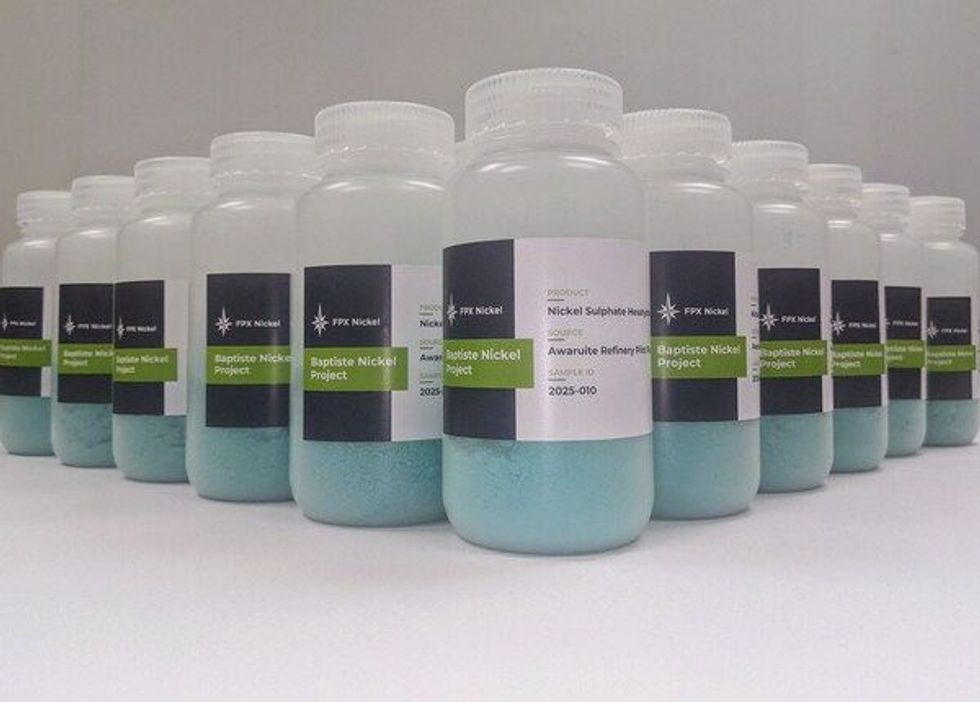
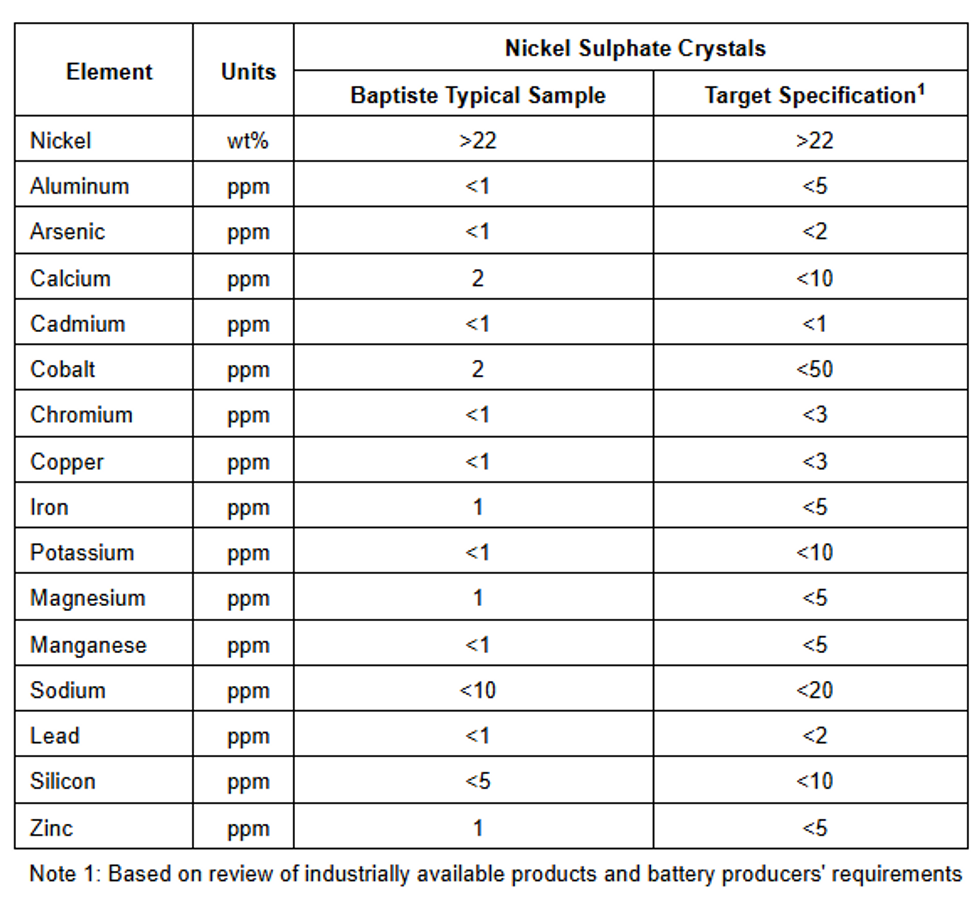
Qualified Person
The metallurgical information in this news release has been prepared in accordance with Canadian regulatory requirements set out in National Instrument 43-101: Standards of Disclosures for Minerals Projects of the Canadian Securities Administrators ("NI 43-101"). Testwork was supervised, reviewed, and verified by Kyle D. Marte, P.Eng., FPX Nickel's Director of Metallurgy and a "Qualified Person" as defined by NI 43-101.
About the Baptiste Nickel Project
The Company's Baptiste Nickel Project represents a large-scale greenfield discovery of nickel mineralization in the form of a sulphur-free, nickel-iron mineral called awaruite (Ni3Fe) hosted in an ultramafic/ophiolite complex. The absence of sulphur and our ability to connect to the BC Hydro grid means that Baptiste has the potential to be one of the lowest carbon-intensive nickel producers in the world and will produce a very high-grade product that does not require any intermediate smelting or complex refining. The Baptiste mineral claims cover an area of 453 km2 west of Middle River and north of Trembleur Lake, in central British Columbia. In addition to the Baptiste Deposit itself, awaruite mineralization has been confirmed through drilling at several target areas within the same claims package, most notably at the Van Target which is located 6 km to the north of the Baptiste Deposit. Since 2010, approximately US$55 million has been spent on the exploration and development of Baptiste.
FPX has conducted mineral exploration activities to date subject to the conditions of agreements with First Nations and keyoh holders.
About FPX Nickel Corp.
FPX Nickel Corp. is focused on the exploration and development of the Decar Nickel District, located in central British Columbia, and other occurrences of the same unique style of naturally occurring nickel-iron alloy mineralization known as awaruite. For more information, please view the Company's website at https://fpxnickel.com/.
On behalf of FPX Nickel Corp.
"Martin Turenne"
Martin Turenne, President, CEO and Director
Forward-Looking Statements
Certain of the statements made and information contained herein is considered "forward-looking information" within the meaning of applicable Canadian securities laws. These statements address future events and conditions and so involve inherent risks and uncertainties, as disclosed in the Company's periodic filings with Canadian securities regulators. Actual results could differ from those currently projected. The Company does not assume the obligation to update any forward-looking statement.
Neither the TSX Venture Exchange nor its Regulation Services Provider accepts responsibility for the adequacy or accuracy of this release.
Keep reading...Show less
09 June
Canada Nickel Announces the Government of Ontario Recognition of Crawford as a Critical Minerals Priority and Nation-Building Project
Canada Nickel Company Inc. ("Canada Nickel" or the "Company") (TSXV: CNC) (OTCQX: CNIKF) welcomed the Government of Ontario's recognition of the Crawford Nickel Sulphide Project ("Crawford") as part of its priority nation building initiatives.
In a joint letter to Canada's Minister of Energy and Natural Resources, Ontario's Ministers of Energy and Mines, Natural Resources, and Indigenous Affairs and First Nations Economic Reconciliation identified the Crawford Project as one of five strategic critical minerals projects ready for near-term development as part of three transformational, nation-building projects. In this open letter provided to media and the Company on June 5, 2025, the Ministers also highlighted additional provincial funding for the sector to fully realize the value of these resources, such as the $500 million Critical Minerals Processing Fund, as well as nearly $3.1 billion in loans, grants, scholarships and other funding to support meaningful Indigenous ownership and partnership in critical mineral development.
"We are encouraged and deeply appreciative of the Government of Ontario advancing the critical minerals agenda and recognizing the strategic importance of the Crawford Project," said Mark Selby, CEO of Canada Nickel. "With aligned federal and provincial support, our experienced management team can continue to advance development of Crawford as an important secure, domestic supply of critical minerals – nickel, cobalt, and North America's only domestic source of chromium—while advancing strong Indigenous partnerships and delivering on Canada's clean energy and climate ambitions."
Located just north of Timmins, the Crawford Project benefits from direct access to power, road, and rail infrastructure, and is supported by long-standing partnerships with Indigenous Nations in the region. In addition to advancing one of the world's largest nickel reserves, Canada Nickel has developed innovative carbon capture technology through its proprietary IPT Carbonation process. Once operational, the Crawford Project is expected to also become one of Canada's largest, carbon storage facilities—contributing meaningfully to both environmental and economic goals and helping to drive long-term prosperity in Northern Ontario and across the country.
About Canada Nickel Company
Canada Nickel Company Inc. is advancing the next generation of nickel-sulphide projects to deliver nickel required to feed the high-growth electric vehicle and stainless-steel markets. Canada Nickel is currently anchored by its 100% owned flagship Crawford Nickel Sulphide Project in the emerging Timmins Nickel District. Canada Nickel Company has applied in multiple jurisdictions to trademark the terms NetZero NickelTM, NetZero CobaltTM, NetZero IronTM and is pursuing the development of processes to allow the production of net zero carbon nickel, cobalt, and iron products. Canada Nickel provides investors with leverage to nickel in low political risk jurisdictions.
For further information, please contact:
Mark Selby, CEO
Phone: 647-256-1954
Email: info@canadanickel.com
Media, please contact:
Melanie Paradis
President, Texture Communications
Phone: 416-399-7400
Email: melanie@yourtexture.com
Sydney Oakes
Director of Indigenous Relations and Public Affairs
Phone: 905-929-7151
Email: sydneyoakes@canadanickel.com
Cautionary Statement Concerning Forward-Looking Statements
This press release contains certain information that may constitute "forward-looking information" under applicable Canadian securities legislation. Forward looking information includes, but is not limited to, drill and exploration results relating to the target properties described herein (the "Properties"), the significance of drill results, the ability to continue drilling, the impact of drilling on the definition of any resource, the potential of the Crawford Nickel Sulphide Project and the Properties, timing and completion (if at all) of mineral resource estimates, the ability to sell marketable materials, strategic plans, including future exploration and development plans and results, corporate and technical objectives, and the completion of assays, follow-up geophysics and further drilling. Forward-looking information is necessarily based upon several assumptions that, while considered reasonable, are subject to known and unknown risks, uncertainties, and other factors which may cause the actual results and future events to differ materially from those expressed or implied by such forward-looking information. Factors that could affect the outcome include, among others: future prices and the supply of metals, the future demand for metals, the results of drilling, inability to raise the money necessary to incur the expenditures required to retain and advance the property, environmental liabilities (known and unknown), general business, economic, competitive, political and social uncertainties, results of exploration programs, risks of the mining industry, delays in obtaining governmental approvals, failure to obtain regulatory or shareholder approvals. There can be no assurance that such information will prove to be accurate, as actual results and future events could differ materially from those anticipated in such information. Accordingly, readers should not place undue reliance on forward-looking information. All forward-looking information contained in this press release is given as of the date hereof and is based upon the opinions and estimates of management and information available to management as at the date hereof. Canada Nickel disclaims any intention or obligation to update or revise any forward-looking information, whether because of new information, future events or otherwise, except as required by law. Neither TSX Venture Exchange nor its Regulation Services Provider (as that term is defined in policies of the TSX Venture Exchange) accepts responsibility for the adequacy or accuracy of this release.
Keep reading...Show less
04 June
Top 9 Nickel-producing Countries
The top nickel producing countries list has been shaken in recent years by Indonesia's rapid rise to the top, beating the Philippines and New Caledonia.
Demand for nickel is mounting. Stainless steel accounts for the vast majority of nickel demand, but electric vehicle (EV) batteries represent a growing application for the base metal as the shift toward a greener future gains steam.
But while nickel's long-term outlook appears bright, it may face headwinds in the short term. Nickel prices have been trending down since breaking US$20,000 per metric ton in May 2024 as weak usage coincides with strong output from top producer Indonesia.
What other dynamics are affecting nickel supply? If you're interested in getting exposure to the market, you should be aware of the factors at play. To get you started, here's a look at the top nickel-producing countries.
Top nickel production by country
This list of the top nickel-producing countries breaks down operations and news affecting the world's top nickel countries in recent years. Figures are based on the US Geological Survey 2025 Mineral Commodity Summary.
1. Indonesia
Nickel production: 2.2 million metric tons
Indonesia's produced a whopping 2.2 million metric tons of nickel in 2024, accounting for more than 50 percent of global output. Claiming first place for production by a long shot, Indonesia is a prime example of a country wanting to get in on the exploding market for nickel. Indonesia also hosts 55 million metric tons of nickel reserves.
Indonesia's output of the base metal has grown tremendously from its 2017 production of 345,000 metric tons. The nation is actively building out its EV battery industry, and Indonesia's close proximity to China, the world’s current leader in EV manufacturing, makes for an ideal setup. In May 2021, the country welcomed the commissioning of its first plant to process nickel for use in EV batteries.
"In just three years, Indonesia has signed more than a dozen deals worth more than $15 billion for battery materials and EV production with global manufacturers," Euronews reported in early 2023.
Major auto maker Ford (NYSE:F) announced in December 2023 that it is taking a direct stake in the proposed US$3.8 billion Pomalaa battery nickel plant, which is planned to produce 120,000 MT of nickel annually using high pressure acid leaching technology.
Zhejiang Huayou Cobalt, one of the world’s largest nickel producers, has a 73.2 percent stake in the project, followed by Vale (NYSE:VALE) at 18.3 percent. Ford has agreed to an initial 8.5 percent interest, with an option to raise it to 17 percent. As of late 2024, Huayou is seeking out banks for roughly US$2.7 billion in financing.
The country's nickel industry has seen several significant changes in 2025, with Indonesia responding to falling prices by significantly cutting its nickel mining quotas and announcing plans to introduce stricter environmental, social and governance practices in its resource industries.
2. Philippines
Nickel production: 330,000 metric tons
In 2024, the Philippines produced 330,000 metric tons of nickel. The country has been one of the top nickel-producing countries for quite some time, as well as a significant nickel ore exporter. Another country in close proximity to China, the Philippines currently has more than 30 nickel mines, including Rio Tuba, operated by Nickel Asia, one of the nation’s top nickel ore producers.
2023 was a big year for the country's nickel mines as total production jumped from 345,000 to 413,000 MT. That surge was projected to continue as two of the Philippines' biggest nickel producers, Nickel Asia and Global Ferronickel, were planning to invest about a combined US$2 billion to build new nickel-processing plants, Bloomberg reported.
However, many nickel miners in the Philippines were forced to reduce or halt production in 2024 as Indonesia's production rates continue to flood the market, resulting in oversupply and declining prices, as per the US Geological Survey.
3. Russia
Nickel production: 210,000 metric tons
Russia produced 210,000 metric tons of nickel in 2024. Even though it holds the third spot on this list of the world's top nickel producers, Russia has seen its nickel output drop from totals seen earlier this decade. In 2020, the nation’s nickel output totaled 283,000 metric tons.
Russia’s Norilsk Nickel is one of the world’s largest high-grade nickel and palladium producers. Nornickel's flagship nickel asset is its Norilsk Division on the Taymyr Peninsula in Siberia, which includes multiple mines, concentrators and metallurgical plants. It also has assets in the Kola Peninsula in Northwest Russia.
In mid-2024, the United States and the United Kingdom joined forces to place a ban on Russian nickel imports.
4. Canada
Nickel production: 190,000 metric tons
Canada’s nickel production in 2024 totaled 190,000 metric tons, up significantly from 159,000 metric tons in 2023. The country’s Sudbury Basin is the second largest supplier of nickel ore in the world, and Vale’s Sudbury operation is located there.
Another key nickel producer in Canada is Glencore (LSE:GLEN,OTC Pink:GLCNF), which owns the Raglan mine in Québec and the Sudbury Integrated Nickel Operations in Ontario. The major miner's Sudbury site includes the Nickel Rim South mine, the Fraser mine, the Strathcona mill and the Sudbury smelter.
Canada Nickel Company (TSXV:CNC,OTCQX:CNIKF) is advancing its Crawford nickel sulfide project toward a construction decision in 2025. In February 2024, the company announced plans to develop a US$1 billion nickel processing plant in Ontario, which once complete would be North America’s largest.
In 2025, Canadian steel and aluminum has become the subject of a 25 percent tariff imposed by the US Trump administration, which he increased to 50 percent in June.
Nickel metal originating from Canada is currently exempt under the Canada-US-Mexico Agreement that replaced NAFTA in July 2020 under Trump's first administration, but the metal's use in stainless steel could cause a trickle-down effect. Last year, Canada was the largest exporter of nickel to the United States, accounting for 46 percent of US nickel imports. That's compared to 11 percent from the next biggest supplier, Norway.
5. China
Nickel production: 120,000 metric tons
China’s nickel production in 2024 was 120,000 metric tons, up slightly from 117,000 metric tons in the previous year. Nickel production in the Asian nation has remained relatively consistent in recent years. In addition to being a top nickel-producing country, China is the world’s leading producer of nickel pig iron, a low-grade ferronickel used in stainless steel. Jinchuan Group, a subsidiary of Jinchuan Group International Resources (HKEX:2362), is a large nickel producer in China.
With Indonesia's surplus weighing on the market, China's position as a major importer of the country's nickel and a top producer of stainless steel means that it also influences nickel price dynamics.
6. New Caledonia
Nickel production: 110,000 metric tons
In 2024, New Caledonia produced 110,000 metric tons of nickel, down more than 52 percent from its output in the previous year. The economy of this French territory just off the coast of Australia depends heavily on its nickel mining industry and the price of nickel, but recently New Caledonia’s nickel industry has been plagued by rising energy costs and sociopolitical unrest.
In February 2024, major miner Glencore made the decision to shutter its Koniambo nickel mine and put it up for sale. The company cited high operating costs and a weak nickel market.
Given these circumstances, the French government has offered a 200 million euro bailout package for New Caledonia’s nickel industry. But the move hasn't gone as planned, with trader Trafigura deciding not to contribute to the bailout of Prony Resources Nouvelle-Caledonie and the Goro mine, in which it has a 19 percent stake.
While the Goro mine remains operational, its future is still in limbo.
7. Australia
Nickel production: 110,000 metric tons
Australia produced 110,000 metric tons of nickel in 2024, a more than 26 percent drop from its output in 2023. One top miner in the country is BHP (NYSE:BHP,ASX:BHP,LSE:BHP) through its Nickel West division.
Australia's largest nickel mines also include First Quantum Minerals' (TSX:FM,OTC Pink:FQVLF) Ravensthorpe and Glencore's Murrin Murrin. Low prices have wreaked havoc on nickel mining in the country, leading to reduced or sidelined operations at six different nickel facilities in the country starting in December 2023, including Ravensthorpe.
The situation was enough to prompt the Australian government to add nickel to its critical minerals list, which allows the country's nickel industry to receive support through the government’s AU$4 billion Critical Minerals Facility.
Australia is the source of 8 percent of US nickel imports according to US Geological Survey data. As of late-April 2025, Australian nickel is not yet the subject of US import tariffs.
8. Brazil
Nickel production: 77,000 metric tons
Brazil’s nickel production came in at 77,000 metric tons in 2024, down nearly 7 percent from the previous year as producers grappled with a weaker market.
Major nickel mining operations in the country include Atlantic Nickel's Santa Rita nickel-copper-cobalt sulfide mine in the state of Bahia. Anglo American (LSE:AAL,OTCQX:AAUKF) is set to sell its nickel portfolio in the country, including its Barro Alto mine, to MMG (OTC Pink:MMLTF,HKEX:1208) subsidiary MMG Singapore Resources for up to US$500 million in cash.
Centaurus Metals (ASX:CTM,OTCQX:CTTZF) is advancing the Jaguar nickel project in the Carajás mineral province. The project hosts a resource of 138.2 million MT at an average grade of 0.87 percent nickel, totaling 1.2 million MT of contained nickel. Jaguar was one of three mining projects selected by the Brazilian government to receive support in obtaining environmental licenses.
9. United States
Nickel production: 8,000 metric tons
Lastly, the United States produced 8,000 metric tons of nickel in 2024, representing a more than 50 percent decline from the national output in the previous year.
The Eagle mine is the only primary nickel-mining property in the US. The asset, located on the Yellow Dog Plains in the Upper Peninsula of Michigan, is a small, high-grade nickel-copper mine owned by Lundin Mining (TSX:LUN,OTC Pink:LUNMF). Output from the mine was exported to smelters in Canada and overseas.
Nickel is included on the US' critical minerals list, and in September 2023, under the Defense Production Act, the US Department of Defense awarded US$20.6 million to Talon Metals (TSX:TLO,OTC Pink:TLOFF) for further exploration and mineral resource definition at its Tamarack nickel-copper-cobalt project in Minnesota.
An environmental review process is underway for the proposed Tamarack underground mine. The company plans to process ore from the mine at a proposed battery mineral processing facility in North Dakota. Talon has said it intends to initiate the permitting process for the facility in 2025.
FAQs for nickel production
How is nickel mined and processed?
How nickel is mined and processed depends upon many factors, such as the size, grade, morphology and depth of the nickel deposit that's under consideration. While lateritic nickel deposits are generally mined from open pits via strip mining, sulfide nickel deposits are often mined using underground extraction methods.
After mining, nickel ore is processed into higher-grade concentrates through crushing and separating nickel-bearing material from other minerals using various physical and chemical processing methods. Next, the concentrates are smelted in a furnace before the final stage of refinement using pyrometallurgical and hydrometallurgical processes.
How bad is nickel mining for the environment?
Nickel mining involves serious environmental concerns, including air and water pollution, habitat destruction, community displacement, wildlife migration pattern disturbances, greenhouse gas emissions and carbon-intensive energy use. Nickel-mining companies looking to supply the EV market are feeling the pressure to lessen the environmental footprint of their operations.
Don’t forget to follow us @INN_Resource for real-time news updates!
Securities Disclosure: I, Melissa Pistilli, hold no direct investment interest in any company mentioned in this article.
Editorial Disclosure: Canada Nickel Company is a client of the Investing News Network. This article is not paid-for content.
Keep reading...Show less
28 May
Ni-Co Energy Set to Mobilize Critical Minerals Exploration just 90 km from Montreal
Ni-Co Energy Inc. announces that its technical team will be mobilized to the Kremer property around mid-June 2025. The project is located approximately 90 km north of downtown Montreal and about 15 km from the nearest municipality, in a remote forested area with access via an existing road and close proximity to the hydroelectric grid.
Meet The Team:
Bilingual Corporate Video introducing Ni-Co Energy Inc.
Summer Field Program Priorities (June–July)
- Targeted prospecting of southwest TDEM conductors (Kremer-2)
To verify the presence of outcropping massive or semi-massive sulfides. - Prospecting of northeast TDEM conductors (Kremer-1 2)
To assess the nature of EM anomalies and any associated metallic indicators. - Analysis of residual conductors in the eastern portion
To refine the global geophysical model ahead of final drill target placement.
Updated Interpretation of the 420 Assays from 2023
The 420 samples from the 22 holes drilled in fall 2023 have been recalculated in terms of nickel equivalent (NiEq %), using metal prices as of May 22, 2025 (Ni = $7.0375/lb, Cu = $4.6559/lb, Co = $15.286/lb).
Indicator | Updated Result |
Samples > 0.5 % NiEq | 134 (≈ 32%) |
Samples > 1.0 % NiEq | 70 (≈ 17%) |
Maximum grade | 3.89 % NiEq |
Average grade (all samples) | 0.48 % NiEq |
These data confirm the presence of significant mineralization, which may be associated with a mafic intrusion interpreted from geophysical surveys. Magnetic, gravity, and EM data show remarkable alignment over 8 km, suggesting a highly favorable environment in the central block (Kremer-2) over a 3 km section — an ideal structural setting for the formation of thicker sulfide lenses.
Next Steps – The Company Anticipates Undertaking a Drill Program in the Fall
- Validate the position and dip of key targets through surface work.
- Mobilize two drill rigs in the fall to test the central fold hinge and associated deep conductors.
- Carry out borehole EM (BHEM) surveys after each drill hole to visualize the extension of mineralized zones or detect off-hole conductors.
Photos of the team, outcrops, and trenches will be shared regularly on the company website, as well as on Facebook, LinkedIn, and X during the campaign.
The scientific and technical information in this news release has been reviewed and approved by Marc Boivin, P.Geo., a Qualified Person under National Instrument 43-101.
About Ni-Co Energy Inc.
Ni-Co Energy Inc. is exploring the Kremer project, a mafic–ultramafic intrusion prospective for nickel, copper, and cobalt, advantageously located in southern Québec and supported by infrastructure and low-carbon hydroelectric power.
For further information, please contact:
Ni-Co Energy Inc.
info@nicoenergy.ca
Click here to connect with Ni-Co Energy Inc. to receive an Investor Presentation
Keep reading...Show less
Latest News
Latest Press Releases
Related News
TOP STOCKS
American Battery4.030.24
Aion Therapeutic0.10-0.01
Cybin Corp2.140.00


